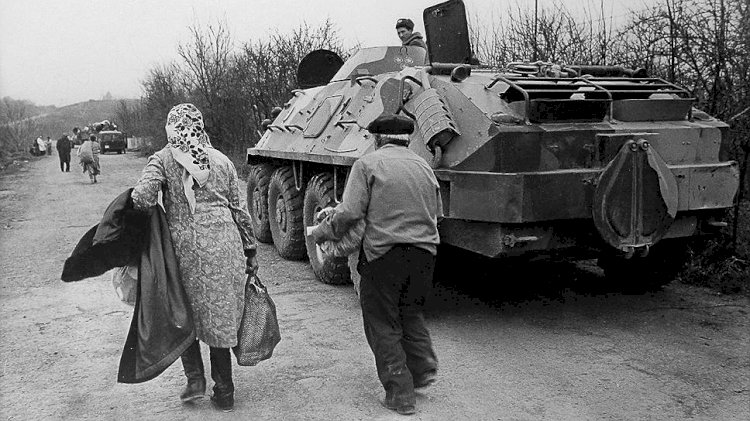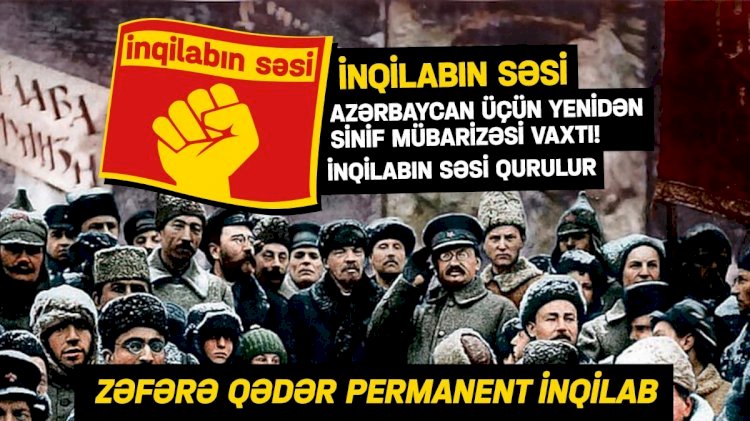The Story of Nagorno-Karabakh Fraught with Conflicts- Denizhan Eren

The conflicts between Azerbaijan and Armenia, which have a historical background of more than a century, have resurged recently. Both sides state that the other one started the attack in the first place. However, considering the aggressive attitudes of both countries towards each other, the debate on who started the war first seems trivial. Both countries seem very pleased about the outbreak of war.
The sensational headlines such as “Stalin’s Bloody Legacy” captioned in the bourgeois press regarding the conflict between the two countries make it important to narrate the historical background of the issue.
Treaty of Turkmenchay
The outbreak of tensions between Armenia and Azerbaijan begins with the Treaty of Turkmenchay signed by Russia and Iran in 1828. One of the problems that arose out of this treaty was the geographical division of the Azerbaijani people into two. Another important problem arose when Russia forced the Armenians that had been living in Iran, the Ottoman Empire, and Russia to migrate because of the 15th article of the treaty.
To illustrate, Armenians from Iran, the Ottoman Empire and South Azerbaijan migrated to Azerbaijan, especially to the Karabakh region, as a result of the Iran-Russia wars in 1804-1813 and 1826-1828. Just during 1826-1828, Iran-Russian War 18 thousand Armenian families migrated to Azerbaijan from Iran. With the Treaty of Turkmenchay signed after the war, Armenian migrations increased even more.
Russia aimed to create polarization among nations and strengthen its sovereignty in the Caucasus. Griboyedov, who was the Russian Ambassador to Iran and played an important role in the signing of the Turkmenchay Treaty, commented about these migrations “The Muslims feared that the Armenians temporarily settled there later would claim these lands. Therefore, Russia provided great rights and advantages to the Armenians in the Caucasus.[1]”
The tensions created by this artificial population policy sowed the seeds of these conflicts that have lasted for many years. For example, in the Armenian-Tatar War between 1905 and 1907, 128 Armenians and 158 Tatar villages were destroyed or pillaged according to Armenian sources. It is estimated that the casualties in this war varied between 3 and 10 thousand. The perpetrators of the massacres during the war were Azerbaijani and Armenian civilian nationalist militants[2]. Until the workers and peasants rebelled and established their powers with the October Revolution, Tsarist Russia kept making the Azerbaijanis and Armenians fight with each other to maintain its sovereignty over the Caucasus for a long time.
October Revolution Opens a New Page
After the oppressed nations had the right to self-determination with the October Revolution, Armenia and Azerbaijan along with Georgia gained their independence and established Transcaucasia Union together. However, this union did not last for very long and it ended de facto in a month. Workers and peasants in Baku rebelled and constituted the Workers’-Peasants’ Government. Armenia, on the other hand, had to get help from the Bolsheviks against the pressure of the Committee of Union and Progress of the Ottoman Empire. In this way, both countries joined Soviet Russia. In the first Transcaucasian Soviet Congress held in Baku on 13th December 1922, the Soviet Socialist Republics of Armenia, Georgia, and Azerbaijan were united and the Transcaucasian Socialist Federative Soviet Republic was declared with Tbilisi as its capital. The Bolsheviks wanted the border disputes between Azerbaijan, Armenia and Georgia to be resolved. The problem for them was not only ethnic and cultural differences between countries, but it was also about economics and class. Marx and Engels declared this for socialists in the Communist Manifesto as follows: “In proportion as the exploitation of one individual by another will also be put an end to, the exploitation of one nation by another will also be put an end to. In proportion as the antagonism between classes within the nation vanishes, the hostility of one nation to another will come to an end[3].” However, in Russia, which was a backward country, it was not possible to establish a socialist society within one country. To succeed this and wipe out the classes, the revolution had to spread throughout the world. For Lenin and Trotsky, who were very aware of this fact, the fraternity of people was only possible with the world revolution.
Nevertheless, a new bureaucracy was rising within Soviet Russia. Before Lenin died, he tried to fight against the “Great Russian Chauvinism” sparked with the rising new bureaucracy. This struggle would be a sign of the clash of two different political stances that would soon peak in the Soviet Union. Stalin, who would be the leader of the newly rising bureaucracy and Russian chauvinism in the future against Lenin, would play a great role in the outcrop of the Karabakh problem. On 1st December 1920, a meeting was held by the participation of the representatives from Azerbaijan, Armenia and the Russian Communist Party, under the chairmanship of Grigori Orjonikidze, the head of the Russian Communist Party for the Caucasus. Narimanov, the leader of the Soviet Azerbaijan under the control of Orjonikidze, declared that they had left Zangezur, Nakhichevan and Nagorno-Karabakh to Armenia and put an end to the historical fight between Muslims and Armenians. In Pravda of 4th December 1920, Stalin considered this decision as “an unprecedented event in the history.” The basis of this statement, which Lenin was also aware of, was that the majority of the Armenians were living in the Karabakh at that time, but the position of the Azeri people was also taken into consideration. In fact, on 21st June 1921, Orjonikidze warned Nerimanov in his letter that “neither even a single Armenian village should be attached to Azerbaijan, nor a single Muslim village should be attached to Armenia.”[4]
However, in the meeting on the 5th of July 1921, Kirov, Orjonilidze, and Narimanov changed their minds in one day with the intervention of Stalin. This time Nagorno-Karabakh was defined as an autonomous region dependent on Azerbaijan. Moreover, when the border of the region was drawn, Lachin was also left to Azerbaijan to interrupt the geographical relations of Nagorno-Karabakh with Armenia. After this policy change, there was no political explanation for this sudden change of opinion.
Why did the attitude of the Caucasus bureau suddenly change with the Stalin intervention? Because, for Stalin, governance of the region was in the foreground rather than freedom and peace among the peoples. The main reason behind this was to support the Armenian Mensheviks’ rebellion on Zangezur Mountain. When the rebellion was suppressed, Stalin had no reason to give Karabakh to Armenians. In addition to this, when Stalin came to power and the dream of international peace with the aim of the socialist revolution was abandoned, he preferred that Armenia and Azerbaijan could be kept under control by conflict and maintained the status quo.
There were similar attitudes not limited to the Karabakh issue at that time.
During the establishment process of the Transcaucasian Socialist Federative Soviet Republic, Orjonikidze, appointed by Stalin, forced Georgian rulers, who did not lean towards Georgia’s inclusion in the Transcaucasian Federation. He even did this through bullying. Stalin backed that up. In his book, Critical Remarks on National Question, Lenin, criticized
Feliks, Dzerjinski, Orjonikidze, and Stalin for this issue and accused Stalin with Great Russian nationalism: “ A fatal mistake was committed on this issue because of Stalin’s managerial haste and his famous passion for social nationalism. This kind of commitment to politics often leads to the worst consequences.” Besides, Lenin recommended in his testament that Stalin should be dismissed from the duty of general secretary because he thought that the power that Stalin would hold could be dangerous.
However, Lenin’s testament couldn’t be put into practice. Stalin, who had already gained strength in the bureaucracy, took the power after Lenin’s death. The objectives of a classless society and the world revolution were abandoned under the name of socialism in one country. Armenia and Azerbaijan were colonized during the newly established state capitalism in Russia. At the same time, the era of Tsarist Russia and Russian nationalism was blessed. For example, a Russian magazine published in 1950 interprets Tsarist Russia’s control over the Caucasus as follows: “Annexation by Russia was the only means of social, economic and cultural development, at the same time; it meant the salvation of the national existence of the Caucasians and Transcaucasians… Annexation by Russia was the only way to save themselves, preserve their ancient culture, and develop economically and culturally[5].”
After Stalin took the power, oppressive rule and the rise of Russian nationalism continued under Kruschev’s and Gorbaçov’s rule. Soviet Russia has established itself in the minds of the oppressed nations as an imposing, anti-democratic, and tyrannical system dominated by oppressor nation chauvinism. That’s why the collapse of the USSR was seen as an opportunity for liberation for many nations such as Armenia and Azerbaijan. However, contrary to the expectations, many states established with the promise of democracy turned into countries where bourgeois dictatorships rule under the tutelage of bureaucrats from the former Soviet mechanism. The Aliyev family in Azerbaijan is a good example.
The Nagorno-Karabakh Problem
The ethnic tensions that have accumulated over a hundred years have been fueled by the nationalist actors who came to power in both countries with the dissolution of the USSR. In February 1988, Armenians in Stepanakert, the capital of the Nagorno-Karabakh Autonomous Oblast (NKAO 1926-1989) within the Azerbaijan Soviet Socialist Republic, demonstrated demanding the union of the province with the Armenian Soviet Republic. The acceptance of the transition of the region to the Republic of Armenia by the NKAO deputies by the majority vote came across the objections of Moscow and Baku. As a counterattack, on 26th November 1989, the Azerbaijan Soviet Socialist Republic administration decided to abolish the autonomous status of Nagorno-Karabakh and attached it entirely to Baku. In response, the Armenian Supreme Soviet and the National Council, which is the legislative organ of Karabakh, declared that the region was united with Armenia three days later. As a result of the referendum boycotted by the Azeri minority in Nagorno-Karabakh in December 1991, when the USSR was officially dissolved, the Armenians decided to establish an independent state. (Armenians constituted 77 percent of the population of Nagorno-Karabakh while Azerbaijanis constituted 23 percent of it.)
When the Soviet government’s proposal to increase the autonomy of Nagorno-Karabakh within the Azerbaijan Soviet Socialist Republic borders was not accepted by the parties, the already tense conflicts between Armenia and Azerbaijan were ignited. Conflicts between the two sides turned into wars and massacres. To exemplify:
On the 27th of February 1988, a group of Azerbaijanis attacked the Armenians in the city of Sumgait, where 19 thousand Armenians were living, and according to the official sources, 26 Armenians and 6 Azerbaijanis died. (According to the unofficial sources, the death toll was more than 200.) Armenians’ houses were pillaged. After the events settled down, 300 thousand Armenians living in Azerbaijan immigrated to the Russian Federation and Armenia, while 250 thousand Azerbaijanis living in Armenia set out for Azerbaijan. That went down in history with the name of Sumgait Pogrom.
On 26th of February 1992, 613 Azerbaijanis including 106 women and 83 children were massacred by the Armenian army in the Khojaly town of Nagorno-Karabakh. Former Armenian President Serzh Sargsyan, who was the commander in Karabakh at that time of the massacre, described it as follows: “The Azerbaijanis thought that they were joking with us, they thought that the Armenians were people who could not raise their hand against the civilian population. We were able to break that [stereotype]. And that’s what happened. And we should also take into account that amongst those boys there were people who had fled from Baku and Sumgayit.[6]” As can be understood from Sargasyan’s words, both of the states found it reasonable to shed blood and saw it as the only way out for their sovereignty.
The Roles of the Countries in International Intervention
The Organization for Security and Co-operation in Europe (OSCE) convened in Helsinki on 24th March 1992 and the Council of Foreign Ministers held a conference in Minsk, the capital of Belarus, to solve the Nagorno-Karabakh conflict. The participants of the Minsk Group were Armenia, Azerbaijan, Germany, USA, Russia, Sweden, Italy, France, Russia, Turkey, and Czechoslovakia. Yet, now when we consider today’s situation, we can see that the Minsk Group has gone nowhere fast because it remained as the diplomatic pillar of the division war of the imperialist countries rather than establishing peace.
To illustrate the attitude of Russia and Turkey:
Russia is one of the countries that have contributed most to the continuance of the conflicts today. The instability caused by the unresolved problem of Nagorno-Karabakh favors Russia to have a military presence in the region under the color of preventing a possible war. For this reason, Russia reinforces a state of constant conflict rather than the development of sustainable peace or relations. One of the indicators of this is that Russia sells weapons to both countries.
The United States- just like Russia- has a stake in this conflictual situation, especially if we consider that the ongoing war is in favor of Azerbaijan for now. In the economic field, Azerbaijan primarily cooperates with the USA while exporting its energy resources to global markets, especially Western Europe.
Besides, the United States has economic gains benefiting from Azerbaijan’s geographical location and access to the Caspian Sea, as well as natural resources such as oil and gas found in Azerbaijan. At the same time, the narrowing of Russia’s area in the Caucasus benefits the USA as the rival of Russia. Even if both sides call for peace, they become interfere indirectly in the region via Turkey. They wait for the appropriate time to intervene and it will not miss the opportunity to do so if suitable conditions arise.
On the other hand, Turkey, while becoming a major center in the transition to the European market for natural gas, plans to send Azeri and Russian gas pipelines through her territory. And, with the discovery of gas fields in the Black Sea, Turkey wants to take the role to export gas to Europe. Therefore, Turkey wants to strengthen its alliance with Azerbaijan with statements of being a friendly nation.
Turkey also aims to increase its influence in the Caucasus policy by promoting nationalism in internal politics. That’s why Turkey’s current attitude is not to establish peace, but to support the chauvinist policies of the Aliyev administration.
Conclusion
It is not possible to get a concrete solution from the bourgeois governments in the power of Azerbaijan and Armenia; because their interests are in favor of conflicts, not resolution. Whenever the Azerbaijani and Armenian regimes are afraid of the public reaction due to their domestic problems, they lead an aggressive, pro-war foreign policy to fuel nationalist feelings and both countries will continue to do so.
It is the same situation for international support. The Minsk group has gone nowhere fast and made the situation even worse. When we consider the attitude of Russia and Turkey and the interests of these countries in the Caucasus, it becomes meaningless to think that the future will be very different.
Only socialism can bring peace to the peoples. Therefore, it can only be possible for the Armenian and Azerbaijani laborers to get rid of the influence of chauvinism and to fight against the rule of the two countries together through a new socialist revolution.
[1] Okan YEŞİLOT, Turkmenchay Treaty and Its Results. https://dergipark.org.tr/tr/download/article-file/33200.
[2] Tadeusz Swietochowski. Russia and Azerbaijan: A Borderland in Transition. Columbia University Press, 1995.
[4] Barsegov, Yu. G. (ed.) (2003) Genotsid Armyan: otvetstvennost’ Turtsii i obyazatel’stva mirovogo soobshchestva. Dokumenty i kommentarii, Vol. 2, Part 1 (Moscow, ‘Gardariki’) p. 635.
[5] Prenodavaniye istoriyi v Şkolye, 1950, No. 6.
[6] https://www.sosyalistgundem.com/daglik-karabag-sorununun-yakin-gecmisi-ve-savasa-karsi-tutum-uzerine-emre-guntekin/



































